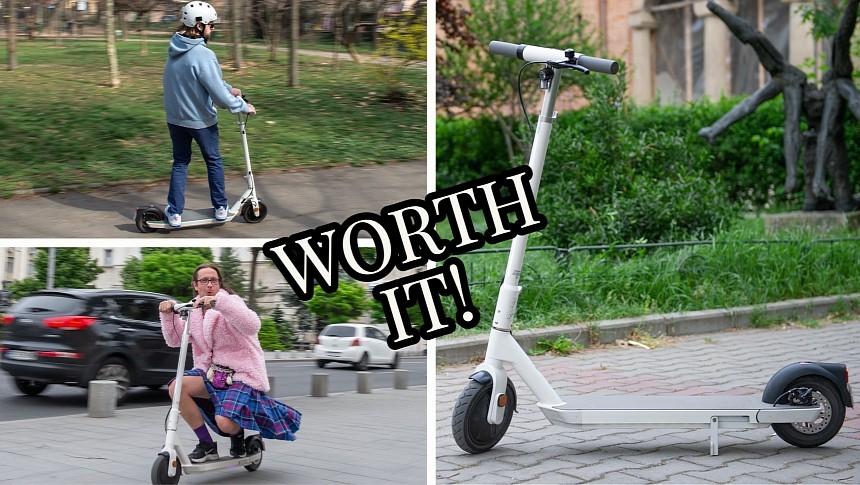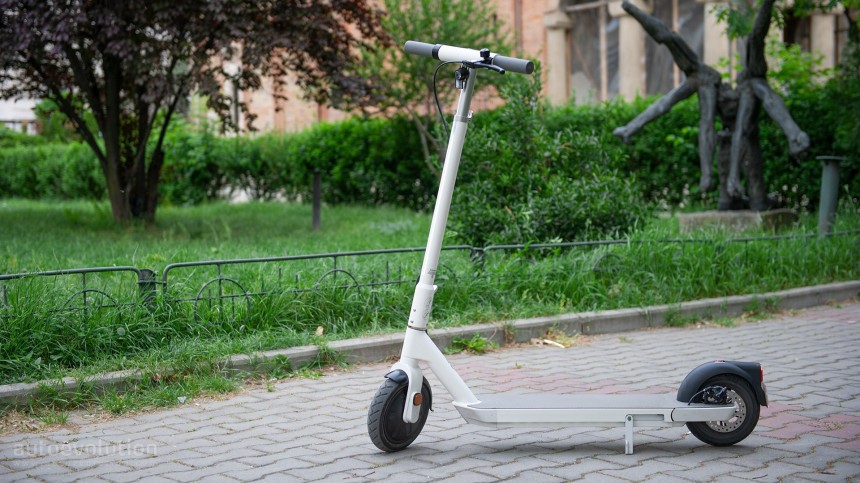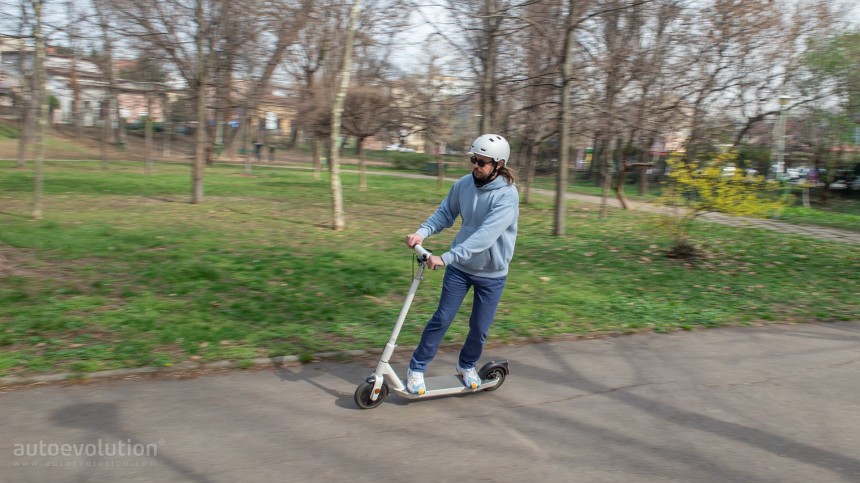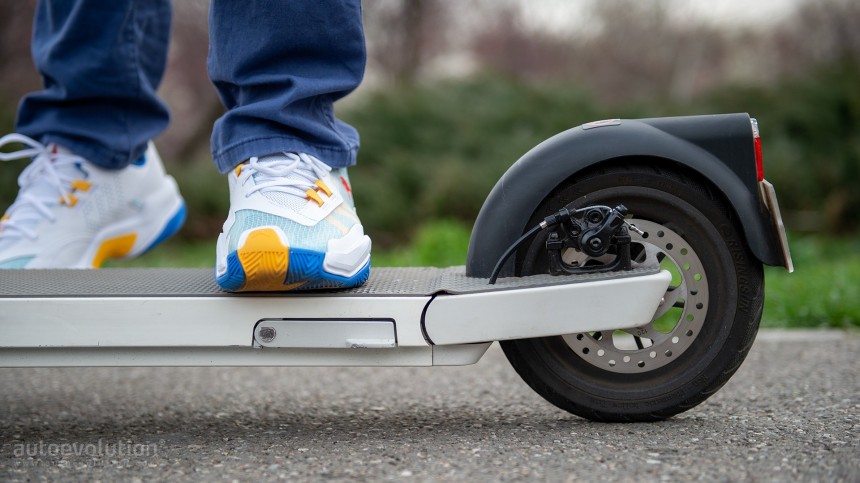A tad over a year ago, Okai, one of the grandfathers of the urban mobility industry, announced they're unveiling their first consumer-destined electric kick scooter, the ES20. Well, I've been abusing it wholly since its first days, and may I say, this thing is one hell of an alternative to moving around your town. Let's see if it's worth the $700.
If you've never heard of Okai, they're a crew responsible for countless rental service scooters and e-bikes you see around your town. Well, 100 or so patents later, they finally decided to offer a mobility solution for folks like you and me. Considering it was their first consumer-ready scooter, I decided to get my hands on one and ride the living hell out of it, and I did!
Okai used only aluminum to craft this machine, but the real attraction here is how they built it. Basing their decision on decades of knowledge, Okai grants the world one of the most comfortable footboards I've found on a scooter within this price range. It's longer than what you'd find on a Ninebot, or even other Okai scooters, mainly the ones used as rental services. This feature is essential in raising comfort and safety, and Okai nailed it!
More on the footboard, the rear quarter of this baby includes a suspension system designed to reduce vibrations the road throws at you. While it's a rather simple system, after over a year of riding, it's still working like it did on day one. This feature is also needed if you're ever running honeycomb tires on your kick scooter, and the ES20's rear tire is a solid one. At the front, however, a pneumatic tire softens up any abuse the road throws at you. Soft at the front and plush at the rear.
From the base of this bugger, you'll see that the steering column extends upward to the cockpit. It's nothing complicated, just good clean fun. But a feature you need to be aware of is the column's ability to fold and reduce the height of the ES20 to a fraction of its initial size. This is essential to help you carry this thing around town with ease.
At the cockpit, large grips ensure you can grab and control the ES20 with ease, and my favorite aspect was the sheer simplicity of this area. The left-hand brake activates the rear disc brake and the electronic one at the front, and a thumb throttle means no pain in your wrist. To help you keep track of everything, a customizable LCD display is also in place. Once internal cable routing is thrown in, the result is a clean-cut and modern machine.
As for my favorite visual aspect of the ES20, it's the presence of "swag lights" in the steering column and footboard. Yes, strips of RGB lighting help bring a tad of color to the minimalist design. These light strips are also the reason why the ES20 carries another name, the Neon.
Okai markets the ES20 as having a range of up to 25 mi (40 km). But those are numbers derived in an optimum test setting. As for myself, I was able to consistently crank out at least 15 mi (25km) of range in High mode. The Low and Eco modes are just too slow for my riding style, but they do have their uses. I often use Eco if I'm riding around slowly in a park. These numbers are made possible by a 9.8 Ah battery pack integrated into that lengthy footboard I mentioned. This battery powers a peak 600 W motor (300 W nominal).
Now, I rode this thing through just about any weather I could, not so much typhoons and blizzards, but you get the idea. I used the ES20 to even ride to work in 32 Fahrenheit (0 Celsius) weather and on sunny days with sweat dripping into my eyes. And every time, I made it to my destination safely. Let's see why that is.
While most manufacturers pride themselves on kick scooters able to spit out massive power, Okai prides itself on safety and comfort with a side of power. It's for these reasons that the footboard is as large as it is, the grips too, and the motor and battery offer the range and capability that they do.
For example, the footboard is the kind that allows you to properly expand your feet, offering a heightened feeling of stability and comfort, but once it's time to brake, you can really settle into it and stop safely. Its length also helps if you're going to be riding around for at least 30 minutes or so.
As for the suspension system integrated at the rear, it's absolutely essential! Let's face it, our cities are rarely perfect, and there has to be a way to smoothen things out. Well, the ES20's rear suspension is more than enough for daily travel. Be it you encounter cracks in the asphalt or even cobblestones, aside from some soft vibrations and auditive effects, there's nothing to complain about whatsoever. Heck, this feature is still holding up like it did on day one. Couple that with a pneumatic front tire, and you're set.
What about power? Well, after a year, that 300 W motor is still going strong. Since I rode this machine even in freezing weather, I won't lie; I'm experiencing up to 5% loss of power from the motor. Still, I'm able to zip around town at speeds of up to 15.5 mph (25 kph), and that motor mounted into the front wheel is responsible for all this. Okai does rate this motor up to a 20% hill gradient, and I believe them. Sure, a few roads are just too big, but for the rest, the ES20 is perfectly fine. Heck, on some of these hills, I can even speed up as I ride.
I mentioned that I'd ridden this thing just about anywhere I could. I've used it to go to work, to the pharmacy, to a friend's place, or to a café on Saturday. Well, that folding frame is a must if you're going to be going into buildings, on buses, or on a metro. Sure, 38.5 lbs (17.5 kg) of the machine isn't the easiest to lug around, but for short maneuvers, it's fine.
One downside of any EV is the battery array. As you know, the more we charge a battery, the less charge it holds in the long run. Well, this applies to the ES20 as well, but after this test, I'm only noticing up to 10% less range, which isn't much considering some of that loss is probably due to me banging this thing around like there's no tomorrow.
Speaking of riding around, I highly recommend enjoying night rides around town on the ES20. Because of those customizable lights integrated into the footboard and steering column, you'll be easy to see and bring a tad of color to your neighborhood for sure. A solid headlight and taillight ensure you see what lies ahead, and those behind you spot your presence.
A few other features you need to know of are things like a kickstand, which I used heavily, an NFC card to unlock and lock your scooter – I lost it in the first two weeks – and a cargo hook integrated into the steering column, used to carry a bag of groceries and/or a backpack. The latter feature is a bit tricky as the heavier the load, the more effect on your steering abilities.
Now, I happened to rack up around 800 miles with the ES20 over the past year. How did I do this? I won't lie; I loaned it to a few friends to put some miles on it. Well, there are some things you need to know about.
First of all, the rear honeycomb tire is a solid one. So, what ends up happening when you slam on your brakes is that the rubber wears down, more so on some surfaces as opposed to others. What does this mean after a year of riding? I will need to dish out around $30 for a new one because it's causing vibrations in my footboard.
Then there are the brakes themselves. First off, there's an electronic brake at the front of the ES20, and that's perfectly fine, but the rear brake pads do need changing. Since all you'll dish out for such a component is around $10 to $15 dollars, the ES20 has cost me a total of $45 bucks. Again, that's after a year of use.
Before I go, keep in mind that Okai has been moving in the background, and the newer generation of ES20s is up for grabs. If this manufacturer only built upon the previous gen, then we can bet our bottom dollar it's going to be even better than what I've tested, and that's something to keep in mind.
P.S. If you're wondering why I'm dressed the way I am in some of the images in the gallery, it has a whole lot to do with those swag lights.
Pros
Cons
Rating: 4.0 / 5
Design Evaluation
Whenever a crew like Okai goes to town on building the first of anything, you can bet your bottom dollar that they really put some thought into things, and the ES20 has been exposed to nearly 19 years of mobility know-how and R&D. Something that really shows once you've had it on hand for over a year.Okai used only aluminum to craft this machine, but the real attraction here is how they built it. Basing their decision on decades of knowledge, Okai grants the world one of the most comfortable footboards I've found on a scooter within this price range. It's longer than what you'd find on a Ninebot, or even other Okai scooters, mainly the ones used as rental services. This feature is essential in raising comfort and safety, and Okai nailed it!
From the base of this bugger, you'll see that the steering column extends upward to the cockpit. It's nothing complicated, just good clean fun. But a feature you need to be aware of is the column's ability to fold and reduce the height of the ES20 to a fraction of its initial size. This is essential to help you carry this thing around town with ease.
At the cockpit, large grips ensure you can grab and control the ES20 with ease, and my favorite aspect was the sheer simplicity of this area. The left-hand brake activates the rear disc brake and the electronic one at the front, and a thumb throttle means no pain in your wrist. To help you keep track of everything, a customizable LCD display is also in place. Once internal cable routing is thrown in, the result is a clean-cut and modern machine.
As for my favorite visual aspect of the ES20, it's the presence of "swag lights" in the steering column and footboard. Yes, strips of RGB lighting help bring a tad of color to the minimalist design. These light strips are also the reason why the ES20 carries another name, the Neon.
Real World Application
Diving deeper into the ES20, let's explore just how it all fared in the real world. One thing you need to consider or keep note of whenever you explore a mobility device such as this is that it can only replace your car or four-wheeler for certain tasks. No, you won't be carrying your kids to school with this single-occupancy vehicle, but for short-range trips to the store, pharmacy, and even to work, it's a solid solution.Now, I rode this thing through just about any weather I could, not so much typhoons and blizzards, but you get the idea. I used the ES20 to even ride to work in 32 Fahrenheit (0 Celsius) weather and on sunny days with sweat dripping into my eyes. And every time, I made it to my destination safely. Let's see why that is.
While most manufacturers pride themselves on kick scooters able to spit out massive power, Okai prides itself on safety and comfort with a side of power. It's for these reasons that the footboard is as large as it is, the grips too, and the motor and battery offer the range and capability that they do.
As for the suspension system integrated at the rear, it's absolutely essential! Let's face it, our cities are rarely perfect, and there has to be a way to smoothen things out. Well, the ES20's rear suspension is more than enough for daily travel. Be it you encounter cracks in the asphalt or even cobblestones, aside from some soft vibrations and auditive effects, there's nothing to complain about whatsoever. Heck, this feature is still holding up like it did on day one. Couple that with a pneumatic front tire, and you're set.
What about power? Well, after a year, that 300 W motor is still going strong. Since I rode this machine even in freezing weather, I won't lie; I'm experiencing up to 5% loss of power from the motor. Still, I'm able to zip around town at speeds of up to 15.5 mph (25 kph), and that motor mounted into the front wheel is responsible for all this. Okai does rate this motor up to a 20% hill gradient, and I believe them. Sure, a few roads are just too big, but for the rest, the ES20 is perfectly fine. Heck, on some of these hills, I can even speed up as I ride.
I mentioned that I'd ridden this thing just about anywhere I could. I've used it to go to work, to the pharmacy, to a friend's place, or to a café on Saturday. Well, that folding frame is a must if you're going to be going into buildings, on buses, or on a metro. Sure, 38.5 lbs (17.5 kg) of the machine isn't the easiest to lug around, but for short maneuvers, it's fine.
Speaking of riding around, I highly recommend enjoying night rides around town on the ES20. Because of those customizable lights integrated into the footboard and steering column, you'll be easy to see and bring a tad of color to your neighborhood for sure. A solid headlight and taillight ensure you see what lies ahead, and those behind you spot your presence.
A few other features you need to know of are things like a kickstand, which I used heavily, an NFC card to unlock and lock your scooter – I lost it in the first two weeks – and a cargo hook integrated into the steering column, used to carry a bag of groceries and/or a backpack. The latter feature is a bit tricky as the heavier the load, the more effect on your steering abilities.
Now, I happened to rack up around 800 miles with the ES20 over the past year. How did I do this? I won't lie; I loaned it to a few friends to put some miles on it. Well, there are some things you need to know about.
First of all, the rear honeycomb tire is a solid one. So, what ends up happening when you slam on your brakes is that the rubber wears down, more so on some surfaces as opposed to others. What does this mean after a year of riding? I will need to dish out around $30 for a new one because it's causing vibrations in my footboard.
Conclusion
To sum up Okai's ES20 in just a few words, all I have to say is, "Go for it!" Once you hop on this bugger, start riding, and see its true potential – helping you save a bit of cash and leading a more physically active life – you'll understand just why Okai stands where they are today: a grandfather of urban mobility.Before I go, keep in mind that Okai has been moving in the background, and the newer generation of ES20s is up for grabs. If this manufacturer only built upon the previous gen, then we can bet our bottom dollar it's going to be even better than what I've tested, and that's something to keep in mind.
P.S. If you're wondering why I'm dressed the way I am in some of the images in the gallery, it has a whole lot to do with those swag lights.
Pros
- Comfortable
- Affordable
- Stable
- Modern and minimalist
Cons
- Could be faster
- Heavy
- loss of power and range
Rating: 4.0 / 5




































